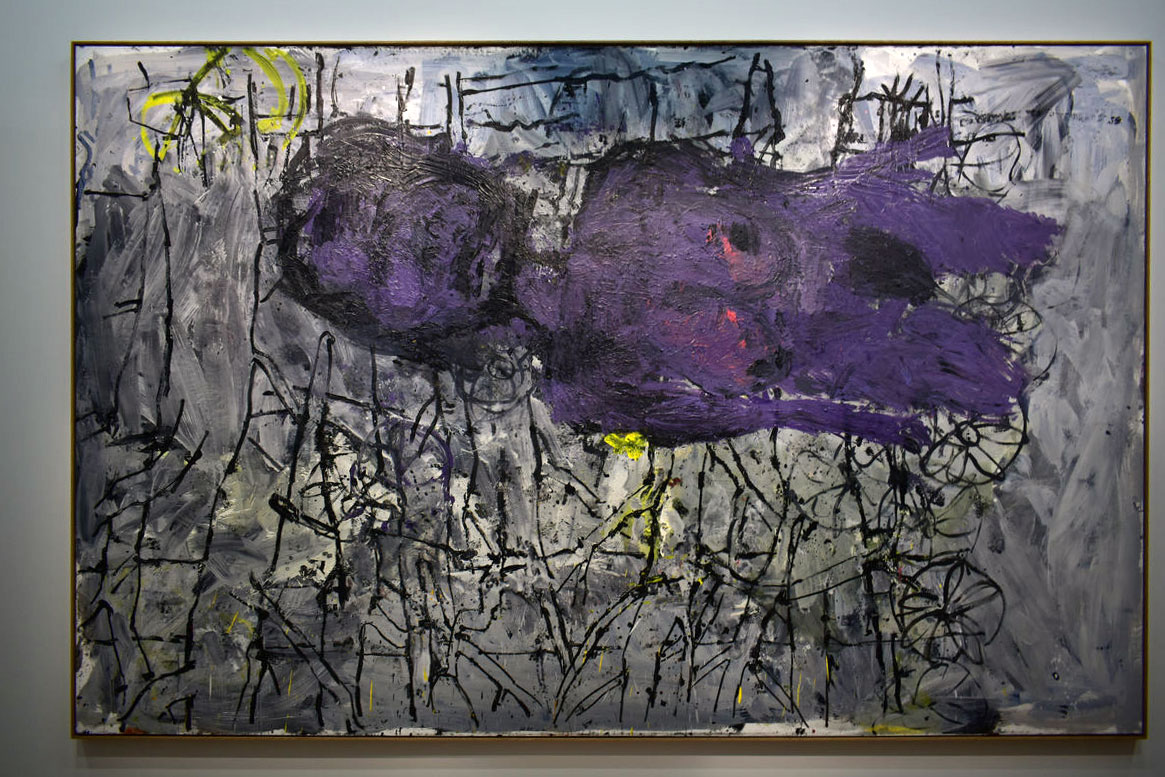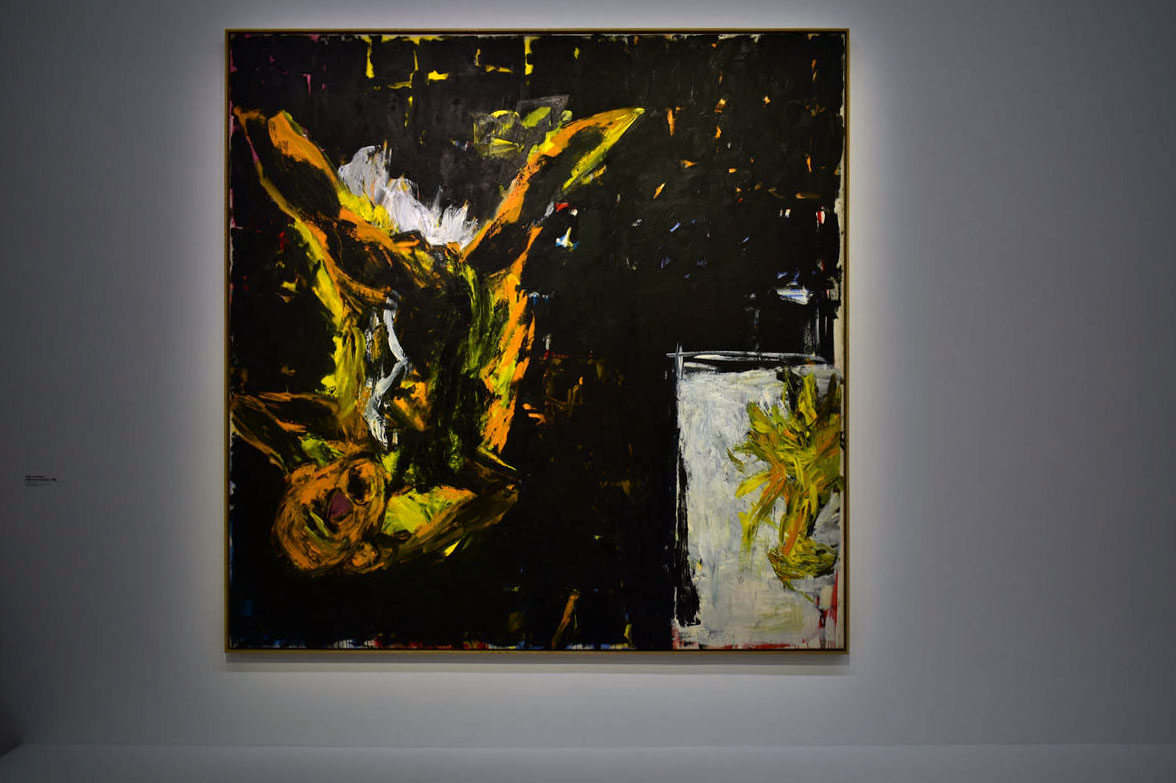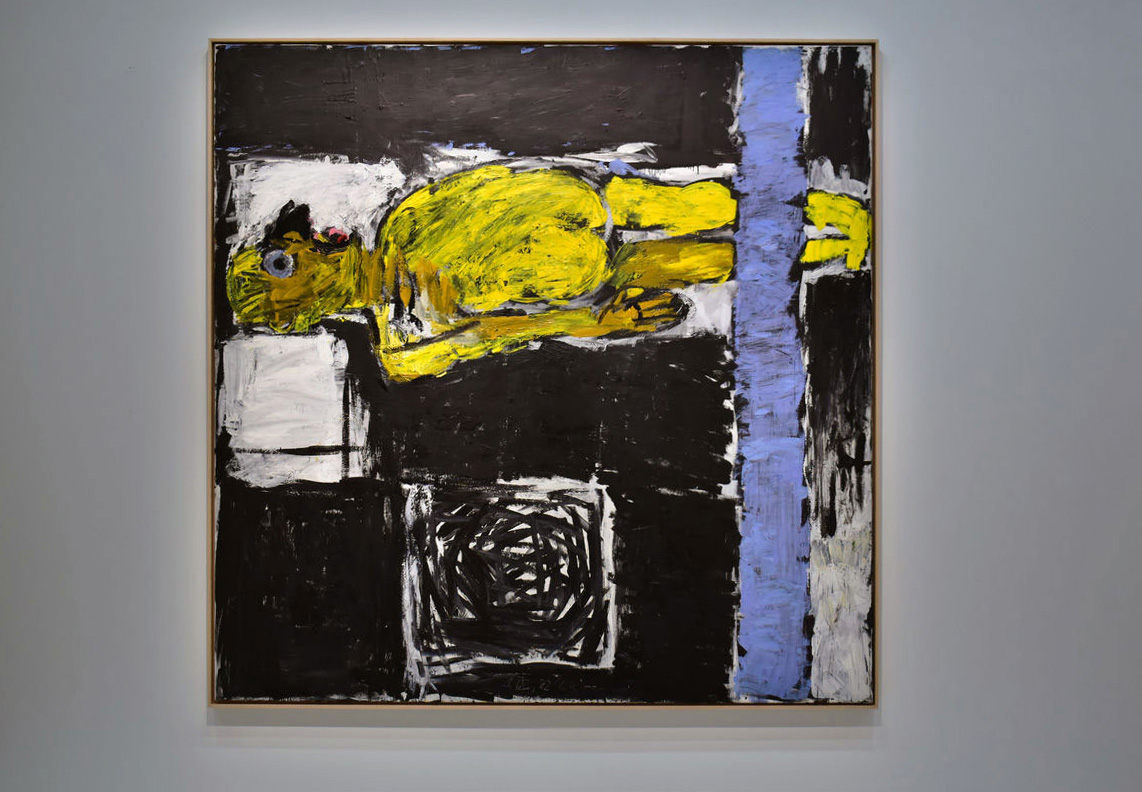TRIBUTE: Georg Baselitz-The Retrospective
 Refuting the ideology conveyed by the Soviet Union through Socialist Realism painting, after passing to the West in 1957, Baselitz discovered the modern and abstract avant-garde that was not taught in the GDR, and soon American Abstract Expressionism. While the art debate was polarised between the defenders of abstract art, a plastic language shared by democracies embodying a form of resilience with regard to the National Socialist past, and the figurative painters who rejected the doctrine imposed by the USSR, the artist sought his own path. He began by taking an interest in singular artists like Antonin Artaud, Jean Dubuffet and the Surrealists, becoming immersed in their works.
Refuting the ideology conveyed by the Soviet Union through Socialist Realism painting, after passing to the West in 1957, Baselitz discovered the modern and abstract avant-garde that was not taught in the GDR, and soon American Abstract Expressionism. While the art debate was polarised between the defenders of abstract art, a plastic language shared by democracies embodying a form of resilience with regard to the National Socialist past, and the figurative painters who rejected the doctrine imposed by the USSR, the artist sought his own path. He began by taking an interest in singular artists like Antonin Artaud, Jean Dubuffet and the Surrealists, becoming immersed in their works.
By Efi Michalarou
Photo: Dimitris Lempesis Archive
In “Georg Baselitz-The Retrospective” are presented six decades of creation along a chronological path highlighting the key periods in the artist’s work. From his initial paintings to the “Pandemonium Manifesto” of the early 1960s, the “Heroes” series or the “Fractures” series of upside-down motifs, begun in 1969, the exhibition also showcases successive ensembles of works in which Baselitz experimented with new pictorial techniques. Various forms of aesthetics unfold, fuelled by references to art history and Baselitz’s intimate knowledge of the work of many artists, such as Edvard Munch, Otto Dix and Willem de Kooning. The exhibition also features his Russian paintings and self-reflective works, “Remix and Time”. In October 1961, Baselitz and his friend Eugen Schönebeck drafted a committed text that focussed on the post-apocalyptic situation of Germany in 1945, “The First Pandemonic Manifesto”. In a literary style that borrowed both from poets and dramatists Samuel Beckett and Antonin Artaud, and from Lautréamont’s Chants de Maldoror, this manifesto generated a series of works whose titles were often preceded by the initials P.D., in reference to the imaginary capital of hell “Pandemonium”. Based on motifs inspired by the Saxony of his childhood and his memories of the war, Baselitz imagined a plastic language that combined an informel practice and elements from naive figuration. His motifs transgressed moral boundaries to the point of creating a scandal with his first exhibition at the Werner & Katz Berlin gallery in 1963. This was followed by a highly publicised trial which labelled Baselitz with the image of a provocative artist that was to stick with him. Georg Baselitz was revolted by the discovery of the horrors committed by Adolf Hitler and the National Socialist regime, and gave expression to his anger. In creating this damaged character, he was inspired by an anecdote about a reading by Irish poet Brendan Behan (1923-1964), during which the poet opened his trousers. The first exhibition of this work at a young gallery in West Berlin in October 1963 created a scandal and led to a highly publicised trial for infringing public morality.
In 1965, Georg Baselitz obtained a grant for a six-month stay at the Villa Romana in Florence. He appreciated the deliberately non-academic approach of the Mannerist painters of the 16th century, and this was an opportunity for him to study their motifs and the way they used distortion in their compositions. On returning to Berlin, he painted the work “B.j.M.C. – Bonjour Monsieur Courbet” (1965) which contributed to the creation of a new body of works having the provocative title “A new Type”, later known as “Heroes”. Georg Baselitz’s point of departure here was the iconography of Romantic, even pathetic representations of “the perfect man”. This new gallery of characters – partisans, painters and poets – wandered through devastated forests and landscapes. With the manifesto-painting “The Great Friends” (1965), the artist claimed to paint a “social parade” in which the individual is always alone in the face of History. In 1966, in search of peace after the trial that crushed him, Georg Baselitz and his family moved to the country, to Osthofen in the Rhineland-Palatinate. There he made a series of large paintings with rural motifs (forest workers, dogs, trees) in which changes in the interpretation increased manifold. These paintings led him toward a new cycle, that of “Fracture paintings”, whose broken motifs evoke tragic destinies in a divided Germany. Baselitz stubbornly insisted on renewing painting when the advocates of conceptual art declared it “dead”. At 30, he was therefore seeking the means to break radically with a faithful representation of reality. While keeping his distance from Pop Art and Capitalist Realism, he worked from photographs to produce his first paintings with inverted motifs. Painted in 1969 and presented as early as 1970 in Cologne by collector Franz Dahlem, they created a sensation. Since then, the artist, who was still struggling to live by his art, would see institutions and some influential collectors taking an interest in his work. In order to avoid being associated with the same “style” throughout his career, he decided to change it regularly. Although he systematically retained the principle of the inverted motif, thereafter the artist varied his methods depending on the gesture, the composition of the image and the components of the painting. These processes created deliberately random aesthetic results, conducive to what the artist called “new images”.
In 1975, Georg Baselitz embarked on his first trip to New York and São Paulo in order to participate in the Biennale of Contemporary Art along with German artist Sigmar Polke. With his wife Elke and two sons, he moved to Derneburg castle in Lower Saxony. There he began a series of nudes of himself and Elke. Painted in a style close to Abstract Expressionism, it testifies to a new approach to the body and to intimacy. The gesture, which became more free and more vigorous, creates compositions that are governed by plays of chiaroscuro, with a deliberately more reduced palette of colors. As early as 1977, Baselitz began to assemble a collection of African art that currently figures among the largest in the world and which inspired him considerably in the early days of his work as a sculptor, and in the course of his different motifs. To represent the FRG at the Venice Biennale, in June 1980 he exhibited his first sculpture, “Model for a sculpture”, alone in the centre of the hall of the German pavilion. Inspired by Lobi figures that raise their arm to stretch the palm of the hand toward the sky, this gesture appeared to be too close to the Nazi salute and triggered another media scandal. This time, however, the inventiveness in the manner of creating a link between tribal sculpture, outsider art and medieval German wood sculpture earned the artist an international reputation. His pictorial motifs varying between self-portraits and representations of bodies in a variety of positions (e.g. on the beach, drinking) are presented against abstract backdrops whose palette is reminiscent of that of Expressionist painters. Baselitz created “The Drummer” in 1982, showing a nude man drumming (or struggling?) between blocks of color with, black, red and gold evoking the German flag. That same year, for the ” Spirit of the Time” exhibition in the Martin-Gropius-Bau, located close to the Berlin Wall of the time, Georg Baselitz created the “Man in Bed” (1982) series. Installed high up when presented, these monumental paintings seemed to float in space like unreachable windows showing individuals who are isolated, threatened and excluded from society. In November 1989, when the Berlin Wall had just fallen, Baselitz immersed himself in his childhood memories, those of the city Dresden, destructed after the bombings of 1945, discovered when he was seven years old. During the year 1990, he continued this work of remembrance by paying homage to the women who cleared the cities stone by stone and actively participated in their reconstruction, the Trümmerfrauen, with the series of sculptures entitled “Women of Dresden” (1990). Between 1991 and 1995, the artist sought to translate his feelings and created an ensemble of 39 monumental pictures, “Picture-Over-Another”. Here he superimposes heads, busts and bodies, of increasingly abstract construction, sometimes reduced to blobs of color, grids of abstract motifs – which the artist calls “adornments”. These large formats necessitate working on the ground, a practice which the artist still uses today. Beginning in 2014, the artist created a cycle of works whose motifs suggest his fragile old body with a material that exudes the pleasure of painting. He was inspired by a dream to paint this motif of an evanescent silhouette, which has obsessed the painter in recent years. Baselitz remembers “a skin, his, that was torn in the middle, split in two” and whose anatomical character, he believes, reflects his physical state. Whether in a self-portrait or a double-portrait, this motif would go on to be varied abundantly in very large formats, using matrices whose imprints are applied to golden, rose-colored or black backgrounds, evoking the vertical compositions of Lucas Cranach and sometimes reworked with a spray, creating effects of veils, causing the body to disappear progressively into darkness. Georg Baselitz’s powerful work testifies to the complexity of life as an artist in post-war Germany and reveals his endlessly renewed questionings; on the possibilities of representing his memories, variations in technique and traditional motifs of painting, aesthetic forms developed over the course of art history, and the formalisms dictated and conveyed by the various political and aesthetic regimes of the 20th and 21st centuries.
Photo: Exhibition view “Georg Baselitz The Retrospective”, Centre Pompidou-Paris, 2021-22, Photo: © & Courtesy Dimitris Lempesis
Info: Curators: Bernard Blistène and Georg Baselitz, Centre Pompidou, Place Georges-Pompidou, Paris, France, Duration: 20/10/2021-7/3/2022, Days & Hours: Mon, Wed & Fri-Sun 11:00-21:00, Thu 11:00-23:00, www.centrepompidou.fr









